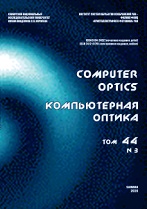|
DIFFRACTIVE OPTICS, OPTICAL TECHNOLOGIES
Spin-orbit interaction in quasi-monochromatic singular beams
Yu. A. Egorov, A. F. Rubass
V. I. Vernadsky Crimean Federal University, Simferopol
Abstract:
It is shown that the magnitude of the spin-orbit coupling is the energy efficiency of energy transfer between orthogonally polarized beam components. The energy efficiency changes as the Gaussian beam propagates through the anisotropic crystal. For a fundamental Gaussian beam, the energy efficiency cannot exceed 50%, and for elegant Hermite-Gaussian and Laguerre-Gaussian beams of higher orders, the energy efficiency can reach a value close to 100%. At the same time, for ordinary higher-order Hermite-Gaussian and Laguerre-Gaussian mode beams, the energy efficiency can only slightly exceed 50%. It is shown that zero-order Bessel-Gaussian beams are capable of achieving an energy efficiency close to 100% when an axial optical vortex is generated in the orthogonally polarized beam component when passing through an anisotropic medium, in both monochromatic and polychromatic light. It is shown that for elegant polychromatic Laguerre-Gaussian or Hermite-Gaussian beams, the energy efficiency is reduced to a value not exceeding 50%. The spin moment is compensated by a change in the orbital momentum of the entire beam, which occurs as a result of the difference in topological charge (TC) in the orthogonally polarized components by 2 units.
Keywords:
structural stability, topological charge, orbital angular momentum, vortex spectrum
Received: 18.01.2023
Accepted: 29.05.2023
Citation:
Yu. A. Egorov, A. F. Rubass, “Spin-orbit interaction in quasi-monochromatic singular beams”, Computer Optics, 48:1 (2024), 18–25
Linking options:
https://www.mathnet.ru/eng/co1207 https://www.mathnet.ru/eng/co/v48/i1/p18
|

| Statistics & downloads: |
| Abstract page: | 19 | | Full-text PDF : | 10 | | References: | 10 |
|




 Contact us:
Contact us: Terms of Use
Terms of Use
 Registration to the website
Registration to the website Logotypes
Logotypes








 Citation in format
Citation in format 